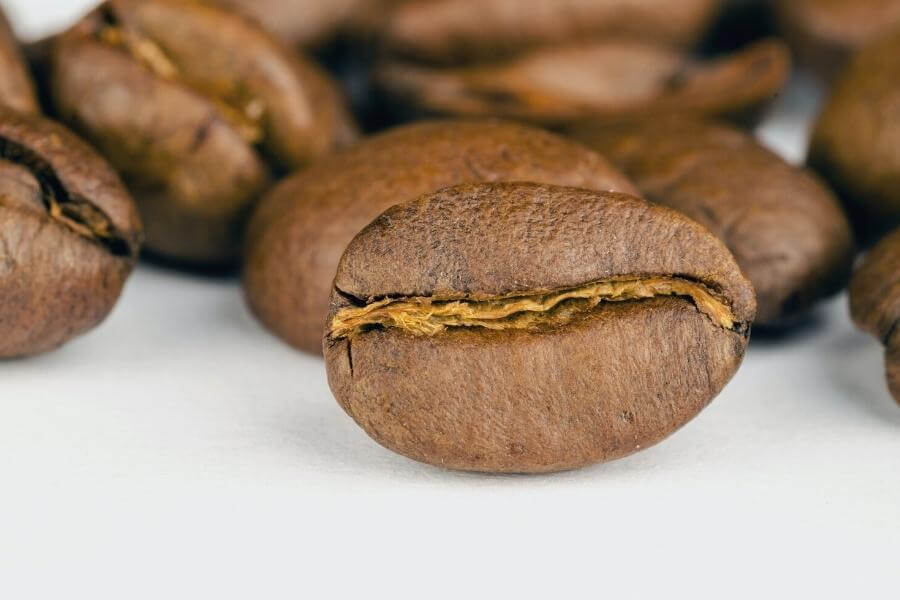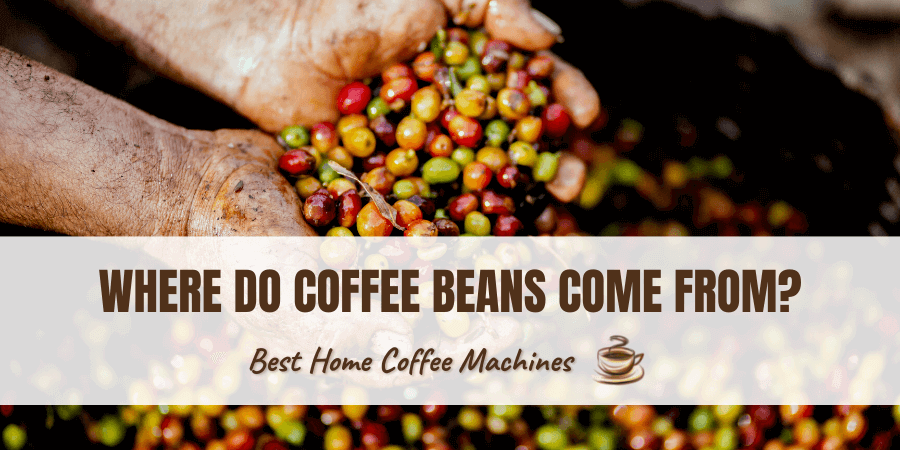Where Do Coffee Beans Come From?
Have you considered how ridiculous it is that coffee — to speak colloquially — is hot bean juice? Curiosity got the better of me, and oh boy, do I have some fun facts for you today!
Even though coffee is one of the world’s most enduring profitable industries, few people are aware of its origins, history, and why “coffee beans” is a misnomer.
In truth, coffee is neither a bean nor a juice. It’s an infusion, made by combining a coffee extract with water (or milk, if you’re a latte fan).
But what is coffee exactly, then? Where do coffee beans come from, and why are they called beans?
There’s a lot of ground to cover here. So, grab a cup, kick back, and join me to discover the where, what, and how of coffee.
What Is a Coffee Bean?
Let’s start with botany because coffee beans come from a plant, though I’m willing to bet it’s nothing like what you imagine…
Coffee plants (of the Coffea genus) are evergreen flowering shrubs. These plants are identifiable by their glossy green oval leaves with prominent veins. Coffea yields clusters of small, white flowers, and, depending on the species, can grow up to 49 feet tall in the wild and live for up to 30 years.
But what’s most interesting about this plant species is its produce: Coffee fruit, also known as the coffee cherry and the coffee berry. These small, grape-like fruits are green when new, and turn crimson when ripe.
Coffee fruit isn’t a popular snack but it’s said to have a mild flavor that’s comparable to raspberries, blackcurrants, and raisins. Research leaves much to be desired, but as it stands, they’re deemed safe for consumption in moderation and may have health benefits including as a weight loss aid and improving brain vitality.
But it’s the inside that matters most. Each coffee cherry produces two seeds that become coffee beans when they are dried and roasted.

Why Are They Called Beans?
An interesting (but somewhat useless) fact is that all beans are seeds but not all seeds are beans. For instance, beans are legume seeds.
Since the coffee plant is not categorized as one of the legume family (Fabaceae) and is one of the Rubiaceae instead, its misnomer is a simple technicality.
It’s unclear who initially mislabeled coffee beans or why, but one plausible explanation is that we call them beans simply because they look like beans!
How Many Types of Coffee Beans Are There?
In truth, no one knows, because botanists stand divided when it comes to coffee’s classification. The accepted estimation, however, is that there are more than 100 species within the Coffea genus, with Jacob’s Coffee stating that 124 different kinds of coffea have been identified.
But most of these species don’t matter to the coffee industry. While a wide variety of beans are used to produce the coffee we drink, there are only four beans that have a real place in commercial coffee.
Arabica (Coffea arabica)
By far the most popular coffee bean, reports claim that Arabica beans account for at least 60% of the global coffee industry. Considering that over 160 million bags of coffee were produced worldwide in 2020, that’s a lot of Arabica.
What makes this bean so special?
For one thing, it has had a massive head start. Arabica is the first coffee bean that humans ever indulged in, more than a thousand years ago. Some call it the “Adam and Eve” coffee bean, and to many experts, it’s the original and best.
Arabica is the standard because its profile is considered just right. It’s known for its smooth, sweet taste, perfect acidity, and mild caffeine content that won’t give you the jitters. Arabica beans lose some of their brightness when served cold or with milk, though, and are best brewed using pour-over and drip coffee makers.
As excellent as Arabica beans are, there are two massive downsides to this bean and both have to do with its cultivation.
First, it grows painfully slowly; some plants take as long as seven years to yield fruit. For a bean in such high demand, this requires a lot of land and also pushes up the price of Arabica coffee.
The second issue is that Arabica plants are sensitive to their environment and can be temperamental to care for. Arabica grows best in the shade, at high altitudes, and in areas with regular rainfall.
When grown outside of these conditions, cultivation can become twice as tedious. Even worse: Arabica is disease-prone. Since it’s grown in such large plantations to meet demand, if one plant is infected, entire crops can be wiped out.

Robusta (Coffea canephora)
These beans take second place in the popularity stakes and are the opposite of Arabica beans in many ways. For example, Robusta has double the caffeine content, is much easier to harvest, and is appreciated for its bold, bitter profile. Robusta won’t lose its integrity when served cold or with milk or cream, so it’s all the rage among iced coffee and espresso enthusiasts.
Robusta plants are basically indestructible. They’ll grow in almost any climate and can withstand a multitude of conditions. Robusta also resists disease — its high caffeine content helps keeps the plant healthy somewhat akin to how our immune systems protect us.
One problem Robusta faces, though, is that it’s a little too easy to produce. As a result, many farmers looking to make a quick buck don’t cultivate it the way it should be grown. Just because Robusta is as persistent as a weed, it doesn’t mean that it should be left to its own devices.
Robusta is best grown in hot, arid climates, though it does require a lot more water. While it won’t die if grown elsewhere, it will lose its flavor profile in unfavorable conditions. Unfortunately, this is common practice, so when shopping for Robusta coffee beans, double-check the region of origin.
Liberica (Coffea liberica)
In the 1800s, coffee rust — a deadly coffea disease — wiped out most of the world’s Arabica supply. Liberica beans rose as the replacement of choice, with farmers in the Philippines dominating its production.
But as the legend goes, political tensions between the US and the Philippines drove Liberica’s exports to a halt and the bean declined in popularity. By the time the world was ready for it again, Arabica had bounced back and Liberica remained in the shadows.
Though uncommon, Liberica is still sought after for its interesting profile. It has a fruity and floral aroma but can taste smokey and woody. Some say that it tastes too dissimilar from coffee, while others appreciate its uniqueness because it’s unlike any other coffee in the world.
Excelsa (Coffea liberica var. dewevrei)
Excelsa beans only make up 7% of global coffee production, but it’s still one of the most popular bean types.
There’s some controversy surrounding the plant itself. First, it was classified as a Liberica plant, then it found its feet outside of the family, only for botanists to reclassify it as a Liberica species once more. Some coffee enthusiasts aren’t too pleased with this decision on the grounds that Excelsa and Liberica have little in common and grouping them together is misleading.
Taxonomies aside, Excelsa may not be prominent in the coffee industry, but it’s still considered a favorite. It’s most often used in blends because its fruity body compliments and enhances the flavors of other beans.
More importantly, Excelsa may be the most unique coffee bean of the lot; it has the profile and flavors of a light roast but the intensity and boldness of a dark roast — an anomaly in the coffee world that attracts drinkers and brewers alike.

Where Do Coffee Beans Originate From?
Learning about the coffee plant raises another important question: where do coffee beans grow? Coffee has a fascinating (and unexpected) history given its popularity in the western world today.
A Brief History of Coffee
Unfortunately, there aren’t any official records of how or when coffee was discovered, but there is strong evidence that the Arabica coffee plant originated in Ethiopia on Africa’s East coast, so naturally, that’s where humans first discovered it.
Legend has it that around 800 AD a goat herder named Kaldi noticed that his goats were hyper after grazing in a coffea field. Deducing that the berries had energizing properties, he reported his findings to the local abbot.
The abbot put Kaldi’s theory to the test by making himself a drink using the berries and subsequently found that it kept him alert through hours of prayer. The abbot shared this discovery with others at the monastery, and from there, word of the invigorating fruit spread through Ethiopia and beyond.
By the 15th century, coffee was cultivated throughout the Arabian peninsula, specifically to be enjoyed by the public. This marks the rise of coffee brewing, and by consequence, the popularity of cafes, or, as they were called at the time, public coffee houses.
Coffee made its way to Europe in the 17th century, and, by way of colonization, arrived in the USA and other countries shortly afterward.
It’s an interesting history but it only seems to cover Arabica coffee. If you’re wondering where Robusta coffee originated, the answer is quite the same. Records show that Robusta beans are native to Africa as well, having been discovered in the Congo (then the Belgian Congo) in the 1800s.
Where Are Coffee Beans Grown?
To fully answer the question ‘where do coffee beans come from,’ we have to look at commercial coffee growing, because ultimately for consumers, coffee beans come from plantations.
Since coffee made its way into the western world, it’s become one of the world’s most valued and exported commodities. Considering the extent of the industry, it isn’t realistic to think that Ethiopia and the surrounding countries are the only producers.
Today, approximately 70 countries cultivate coffee, with the wide majority of these countries located within the so-called bean belt — an area said to have the best, and therefore most fruitful, conditions for coffee growing.
The bean belt is a strip situated between the Tropic of Capricorn and the Tropic of Cancer that spans the circumference of the globe. The top coffee producers in the world, including Brazil (the number-one coffee producer), Indonesia, Ethiopia, Honduras, Colombia, Vietnam, and many more are in the bean belt.
While this isn’t the only area where coffee can grow, chances are that the beans you enjoy came from the bean belt — be it craft brews, cafe coffee, or pre-packaged grinds you bought at the supermarket.
What if you’d like to know exactly where your coffee comes from? Well, most of the time, you can find your coffee’s origin by checking the production information on the packaging, and cafes tend to describe their coffees on menus or plaques. But if all else fails, you can always research the company!

Conclusion
Coffee beans are not as simple or straightforward as they seem, and their history and origins may be surprising to those who take them at face value. While the coffee industry is dominated by producers in South America and distributors in Europe, the bean itself was given to us by Africa.
Knowing where coffee beans come from and what exactly they are may not make a difference to how you drink your coffee, but it’s a fascinating subject. Now you can impress everyone you know with these cool facts and sound like a connoisseur.
Which bean do you prefer? Let me know in the comments, and don’t forget to share this article so others can enjoy it too!
Coffee Beans FAQ
Can You Eat Raw Coffee Beans?
There aren’t any negative effects to eating raw coffee beans, but they have a reputation for tasting awful. Unroasted coffee beans are extremely acidic and bitter. They’re also difficult to chew.
Is It True That Coffee Beans Come From Poop?
No! Only one type of coffee — Kopi Luwak — is made by extracting partially digested coffee beans from civet feces. Oddly enough, Kopi Luwak is the most expensive coffee in the world.
You can rest easy though, the coffee you enjoy every day is harvested directly from coffee plants and hasn’t passed through any digestive tracts before hitting your cup!
Can You Grow Coffee Beans At Home? Is It Legal?
Absolutely, though it won’t be easy, and will require a fair amount of commitment. Coffee plants need specific attention and care to flourish, and it can take years for a single plant to yield fruit.
How Are Coffee Beans Processed?
Coffee beans go through a complex process that takes them from coffee plants to your kitchen. We have an article that covers this in detail. Check it out if you please!





